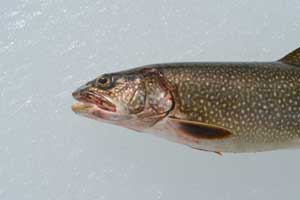Lake Trout Winter and Ice Fishing

Jigging is the most effective form of ice fishing for Lake Trout, even if it seems as though the fish have lost interest. Keep in mind that people aren’t the only creatures to slow down in winter. Lake Trout and other fish slow down significantly into a semi hibernation state.
When your Ice Fishing Lures aren’t working
If your jig isn’t working try changing things up a bit. Here’s 3 things to try
- different size lures
- changing the lure color
- different types of spoons
If jigging continues to fail, then it’s time to try your hand at tubes.
You might have a lure that’s hot for a few days or even just one and then it fails to work. This is not uncommon. When a hot lure stops working it’s time to change it up unless all you want to do is look into an empty hole all day.
During winter, Lake trout will eat a wider variety of baits.
Baits to use for trout
In the summer, smelts, herring and alewives are very popular. However winter finds the Lake Trout regularly going after suckers, mud minnows, perch, ling, insects and in particular, fresh water shrimp.
The advantage of tubes is that they can easy replicate the look of all prey that the Lake Trout enjoys in winter. If you’ve never tried tubes, take the fall to learn and be ready for winter.
Ice Fishing Holes
If your fishing hole hasn’t produced anything, consider moving to another one. If drilling a hole is too time consuming and tiring, get a motor auger to power thro0ugh and eliminate this concern.
Needing to buy an auger?
Winter brings equality to the lakes and rivers. The temperature differential in winter is minor between the surface and the bottom. Don’t stay at the same hole hoping that the fish will come to you. This is not an effective strategy for any hunter.
Most lakes have many good areas that fish are spending their time and at different depths.
Winter Fishing Safety
Pay attention to lake and river warnings especially for areas you’re not familiar with. It’s easy to avoid falling through the ice and being a victim of thin ice. Check with the local police, tackle shop or any other marine business about ice safety.
The dangers are that large lakes freeze and melt unevenly and currents can eat away at the ice. Look out for jutting points as there are usually pressure ridges and thin ice setting out from these points.
Keep a compass with your tackle. Wind can quickly reduce visibility to where the shoreline is hidden when only a mere 100 feet from shore.



